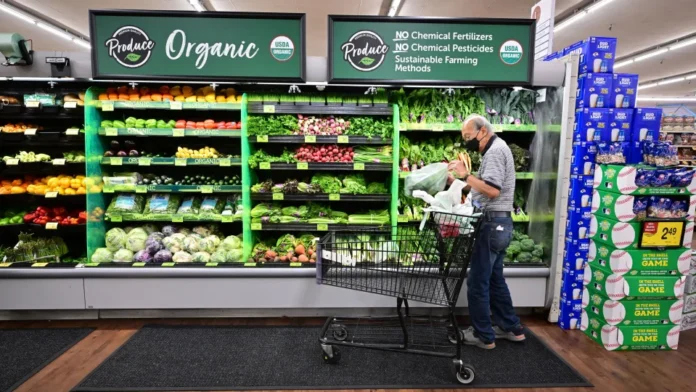Consumers find nutrition claims on food labels misleading. Food safety and nutrition labels are strictly regulated by the government, while sell-by dates and animal welfare labels are not.
Trying to understand food labels in the grocery store is overwhelming. Even when explicitly specified, nutrition statements like “sugar-free” or “reduced fat” are difficult to interpret.
Shoppers who want to know where their food originates from or how long it will last must work harder.
Government agencies strictly regulate food safety and nutrition labels on packaged foods. Others, like sell-by dates and animal welfare labels, are unregulated and meaningless.
Reading food labels: how to recognize them.
“Organic” means anything different depending on the food.
Farmers must avoid synthetic pesticides, weedicides, disease, and soil treatments to have USDA-certified organic produce.
Use approved substances and farming methods like cover crops and crop rotation to maintain soil health to manage your operations. Genetically modified seeds are prohibited.
Animal goods have different requirements. Organic food and vitamin and mineral supplements are required for livestock. Poultry and cattle need year-round outdoor area.
For USDA-certified organic packaged foods, at least 95% of the ingredients must be organic.
The USDA stated in a 2016 blog post that “not all USDA graded eggs are cage-free, and not all cage-free eggs are graded by USDA.”
Egg sellers don’t have to disclose hen treatment. However, they can employ a third party or the USDA to certify their chickens as “cage free” or “free range.”
Fees apply to USDA-certified companies.
The USDA allows cage-free birds to “freely roam a building, room or enclosed area with unlimited access to food and fresh water during their production cycle.” They need perches, nests, and predator protection.
The agency said farms may have diverse looks.
The USDA added that free-range chickens should have “continuous” outdoor access during their laying cycle. That outdoor area may be fenced or netted.
The government usually lets corporations self-report animal welfare claims.
“There are no [Food Safety and Inspection Service] regulations specifically addressing animal-raising claims,” a spokesman said. Animal-raising claims are considered ‘special statements’ and must be FSIS-approved before use in commerce.
Animal product processors don’t have to tell customers how animals are raised, but they must follow guidelines if they do. Companies must provide proof of third-party certification and animal raising documents to the government.
The government provides label recommendations.
According to the USDA, the optional claims “raised without antibiotics,” “no antibiotics ever,” or similar ones apply solely to meat from animals that were not given antibiotics in their diet, water, or production process.
The agency is considering strengthening its claim-substantiation requirements.
In June, FSIS announced a sample effort with USDA’s Agricultural Research Service (ARS) to examine antibiotic residues in cattle for the ‘raised without antibiotics’ market. It said the data will help it decide whether to improve the approach.
Companies designate antibiotic kinds. Tyson’s chicken has “no antibiotics important to human medicine.” Companies must have FSIS approval to use this and similar labels.
The FSIS stated that a meat processor can only label beef as “grass fed” if it came from cows who were fed solely grass after weaning. “This means 100% grass-fed animals are never confined to a feedlot,” receiving pasture throughout the growing season.
It’s different from “grass finished,” which allows animals to have been fed grain before switching to grass.
Here, things get murky.
There is no USDA labeling policy for “pasture raised,” the agency said.
Other claims include “free roaming,” “pasture fed,” and “meadow raised,” according to FSIS.
In some circumstances, corporations define and explain the terminology to FSIS or use third-party certifiers. No standard definition exists.
Consumers may believe that “humane” or “sustainable” on a label means grass-fed or pasture-raised. However, compassionate and sustainable have no defined meaning in this context.
The Animal Welfare Institute’s farmed animal program director, Dena Jones, said producers define these phrases. They often define public-identified value-added claims, such as compassionate or sustainable, with industry standards.
Jones worries about this ambiguous phrasing. “Consumers are deceived,” she claimed.
Animal Welfare Institute wants tougher definitions or higher requirements for ethical, sustainable, pasture-raised, and free range.
The USDA states that several brands use the word humane, but “the verification of these claims varies widely.”
Jones said consumers who want to understand those ambiguous terms might explore the brand’s website, but they may not find anything.
Third-party certification labels on animal products are another option.
Nonprofits including American Humane, Global Animal Partnership, and A Greener World have certification programs with standards and reviews.
Their websites give consumers and manufacturers details about each.
There is no national standard for “enjoy by,” or “sell by,” dates for most foods.
In most cases, the sell-by date, or expiration date, is the company’s estimate of when a meal will taste best, not when it will become hazardous.
Shelf-stable foods can be eaten after a “best if used by date,” but fresh meat and poultry can go bad before the label date.
FSIS provides a handbook for consumers seeking advice.
If stored properly, many canned items can survive one to five years, according to the organization. Rice and dry pasta can last two years under ideal conditions. Some meats should be cooked or frozen within two days of purchase.
Conclusion
Consumers find nutrition claims on food labels misleading. Food safety and nutrition labels are strictly regulated by the government, while sell-by dates and animal welfare labels are not. Farmers must use allowed ingredients and farming methods to grow organic food. Animal products need organic food, vitamins, and outside space. At least 95% of packaged food ingredients must be organic. Companies can self-report animal-raising claims with USDA approval. The administration is considering strengthening claim verification criteria.
The USDA does not label “pasture raised,” “free roaming,” “pasture fed,” or “meadow raised,” confusing consumers. The Animal Welfare Institute wants stricter definitions and higher standards for these terminology. Brand websites and third-party certification seals provide extra information. There is no national food expiration date standard, however FSIS provides shelf life guidance.




